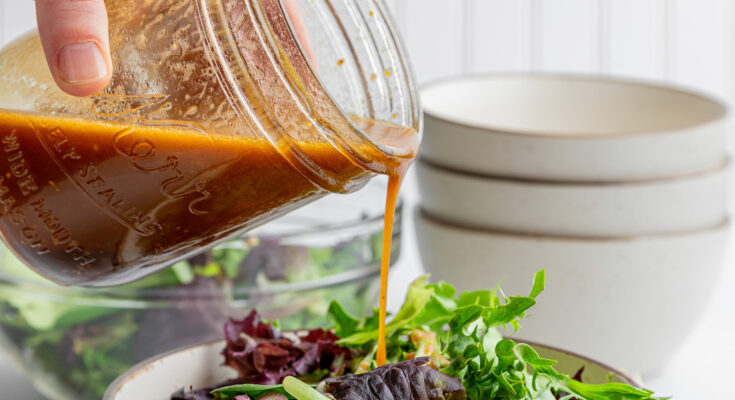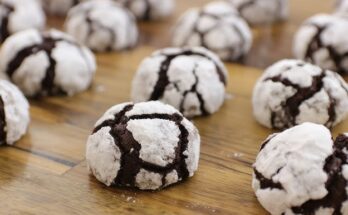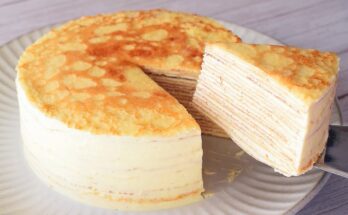Balsamic Salad Dressing Recipe: When it comes to salads, the dressing is what truly transforms a bowl of greens into a mouthwatering dish. Among all dressings, balsamic salad dressing stands out for its rich, tangy, and slightly sweet flavor. Unlike store-bought bottles that are often filled with preservatives, added sugars, and artificial flavors, making balsamic salad dressing at home gives you full control over the ingredients. This not only ensures a fresher, healthier option but also allows you to customize the taste to your liking.
Balsamic dressing pairs beautifully with everything from fresh garden salads to roasted vegetables, grilled meats, or even as a drizzle over strawberries. Its versatility makes it a kitchen essential, and once you master the step-by-step process, you’ll never go back to the store-bought versions again. In this guide, we’ll walk you through everything you need—from the list of simple ingredients to a foolproof method for making the perfect balsamic salad dressing at home.
Ingredients You’ll Need
Core Ingredients
The beauty of balsamic salad dressing lies in its simplicity. You don’t need a long list of complicated items—just a handful of pantry staples:
- Balsamic Vinegar (½ cup): The star ingredient, providing tang and depth. Opt for a high-quality aged balsamic for the best flavor.
- Olive Oil (1 cup): Extra virgin olive oil is ideal, as it balances acidity with smooth richness.
- Dijon Mustard (1 tsp): Helps emulsify the dressing and adds a subtle kick.
- Honey or Maple Syrup (2 tbsp): A natural sweetener that balances the tanginess of vinegar.
- Garlic (1 clove, minced): Adds bold flavor and depth.
- Salt and Pepper (to taste): Essential seasonings to enhance the overall taste.
These six ingredients form the base of a classic balsamic dressing, creating a balance between tangy, sweet, and savory flavors.
Optional Add-Ins for Extra Flavor
Want to take your balsamic dressing to the next level? Here are some optional ingredients to experiment with:
- Fresh Herbs (basil, thyme, or oregano): Add freshness and aroma.
- Shallots (finely minced): Give a mild, sweet onion flavor.
- Parmesan Cheese (grated): For a creamy, umami-rich twist.
- Red Pepper Flakes: For a touch of heat.
- Lemon Juice or Zest: Brightens the flavor profile.
These additions allow you to tailor the dressing to your personal preference or the dish you’re serving.
Ingredient Substitutions and Variations
Not everyone has the same pantry or dietary needs, so here are some smart substitutions:
- Oil Substitute: Avocado oil or walnut oil can replace olive oil for unique flavors.
- Sweetener Alternatives: Use agave nectar, coconut sugar, or stevia for dietary preferences.
- Vinegar Variation: White balsamic vinegar offers a lighter, milder flavor.
- Mustard Options: Whole-grain mustard can replace Dijon for a rustic taste.
By swapping just one or two ingredients, you can create countless variations of balsamic dressing that cater to different dietary needs or flavor profiles.
Step-by-Step Guide
Step 1 – Gather Fresh Ingredients
The first step in making an amazing balsamic salad dressing is ensuring your ingredients are fresh and high quality. Using a premium balsamic vinegar will make a huge difference, as cheaper versions often lack depth and may taste overly acidic. Similarly, extra virgin olive oil adds a luxurious smoothness that a basic cooking oil can’t match. Lay out all your ingredients on the counter before you start mixing—this makes the process smoother and ensures you don’t forget anything.
Think of this step like prepping for a painting: your ingredients are the paints, and the salad bowl is your canvas. When you start with the best, the end result is guaranteed to shine.
Step 2 – Combine the Base Ingredients
In a small bowl or mason jar, pour in ½ cup of balsamic vinegar and 1 cup of olive oil. These two are the backbone of the recipe. The ratio is crucial: typically, a vinaigrette follows a 1:2 ratio of vinegar to oil, which creates the perfect balance between tanginess and richness.
Whisk the mixture lightly to start blending them together. At this stage, you’ll notice the oil and vinegar won’t completely mix yet—that’s normal. We’ll fix that later when emulsifying.
Adding Dijon mustard at this point helps bind the ingredients, so don’t skip it unless you absolutely have to. It acts as a natural emulsifier and adds a subtle sharpness that balances the sweetness.
Step 3 – Add Seasonings and Enhancers
Now comes the fun part—building layers of flavor. To your vinegar and oil mixture, add 1 teaspoon of Dijon mustard, 2 tablespoons of honey or maple syrup, and 1 minced garlic clove. Sprinkle in a pinch of salt and freshly cracked black pepper.
The Dijon mustard gives the dressing its body while the sweetener balances the tang of balsamic vinegar. Garlic, on the other hand, infuses a bold kick that elevates the dressing. Don’t be afraid to adjust these seasonings based on your preference. If you like it sweeter, add more honey; if you like it punchier, go heavy on the garlic and pepper.
This stage is like seasoning a soup—you taste and tweak as you go. The goal is harmony between sweet, savory, and tangy flavors.
Step 4 – Emulsify the Dressing
This step is where the magic happens. Since oil and vinegar naturally separate, you’ll need to emulsify them into a smooth, unified dressing. You can do this in several ways:
- Whisking Method: Use a whisk and beat vigorously until the mixture thickens slightly.
- Jar Method: Place all ingredients in a mason jar, screw on the lid, and shake until creamy.
- Blender Method: For a silky-smooth texture, blend the mixture for 15–20 seconds.
Emulsifying is crucial because it prevents the dressing from splitting too quickly when poured over salad. A good balsamic dressing should cling to your greens rather than pool at the bottom of the bowl. Think of emulsification as creating a “marriage” between the oil and vinegar—they finally come together and stay together.
Step 5 – Taste Test and Adjust
Every palate is different, which means your dressing should be tailored to your liking. After emulsifying, dip a spoon—or better yet, a piece of lettuce—into the dressing and taste.
- Too tangy? Add a little more honey or oil.
- Too oily? Whisk in more vinegar.
- Too sweet? Balance with extra mustard or a squeeze of lemon juice.
This step ensures your dressing isn’t just “good” but perfect for you. Remember, homemade dressings are meant to be flexible—you’re the chef, so trust your taste buds.
Tips for the Perfect Balsamic Dressing
Making balsamic salad dressing might seem simple, but a few insider tips can elevate it from average to restaurant-quality.
- Use High-Quality Balsamic Vinegar: Aged balsamic has natural sweetness and depth.
- Stick to Extra Virgin Olive Oil: It adds richness without being greasy.
- Balance Sweetness and Acidity: Always aim for harmony rather than dominance of one flavor.
- Make Small Batches: Fresh dressing always tastes better than something that’s been sitting for weeks.
- Experiment with Herbs: Fresh basil, thyme, or oregano can completely transform the flavor profile.
Think of these tips as your safety net—they ensure your dressing consistently turns out smooth, flavorful, and vibrant.
Common Mistakes to Avoid
Even though balsamic dressing is beginner-friendly, there are a few pitfalls that can ruin the flavor.
- Using Low-Quality Vinegar: Cheap balsamic often tastes too harsh and acidic.
- Overpowering Garlic or Mustard: A little goes a long way; too much will mask other flavors.
- Skipping Emulsification: If you don’t blend properly, the dressing will separate too quickly.
- Adding Too Much Sweetener: Balance is key; you don’t want your salad tasting like dessert.
- Storing Improperly: Leaving it uncovered or at the wrong temperature can make it spoil faster.
Avoid these mistakes, and you’ll always have a dressing that enhances rather than overwhelms your salad.
Nutritional Benefits of Balsamic Salad Dressing
One of the biggest advantages of making your own balsamic salad dressing is knowing exactly what’s in it. Store-bought versions often contain hidden sugars, preservatives, and unhealthy oils that reduce the nutritional value. A homemade balsamic dressing, on the other hand, is packed with health benefits:
- Rich in Antioxidants: Balsamic vinegar contains polyphenols, which protect cells from damage and support heart health.
- Supports Digestion: Vinegar naturally aids in breaking down food and improving gut health.
- Healthy Fats from Olive Oil: Extra virgin olive oil provides monounsaturated fats that support brain and heart health.
- Low in Calories: Compared to creamy dressings like ranch or Caesar, balsamic vinaigrette is much lighter and won’t derail your diet.
- Natural Sweeteners Instead of Refined Sugar: Using honey or maple syrup provides energy without processed additives.
So, every time you drizzle this dressing on your salad, you’re not just adding flavor—you’re giving your body a dose of goodness too.
Pairing Ideas
Balsamic salad dressing isn’t limited to leafy greens. Its versatile flavor profile means it can enhance a wide variety of dishes.
- Classic Green Salads: Spinach, arugula, or mixed greens taste amazing with balsamic’s tangy-sweet kick.
- Caprese Salad: Fresh mozzarella, tomatoes, and basil drizzled with balsamic dressing is a timeless Italian favorite.
- Roasted Vegetables: Carrots, Brussels sprouts, and zucchini come alive with a balsamic glaze.
- Grilled Meats: Use as a marinade or finishing drizzle for chicken, steak, or fish.
- Fruit Pairings: Believe it or not, strawberries, peaches, and even watermelon taste incredible with balsamic dressing.
Think of balsamic as the “black dress” of dressings—it goes with almost everything, whether you’re aiming for simple or sophisticated.
Storing and Shelf Life
Homemade balsamic salad dressing is best enjoyed fresh, but with the right storage, it can last up to two weeks.
- Refrigeration: Store in a tightly sealed glass jar in the fridge. Shake well before each use since natural separation will occur.
- Room Temperature: If you exclude fresh garlic or herbs, it can safely be stored at room temperature for about a week.
- Freezing: Not recommended, as oil and vinegar don’t freeze well together.
A good rule of thumb: always check for changes in smell or appearance before using. Since homemade versions don’t contain preservatives, they won’t last as long as store-bought—but the flavor payoff is worth it.
Variations of Balsamic Salad Dressing
Bored of the same taste every time? Try these exciting twists:
- Creamy Balsamic Dressing: Add Greek yogurt or mayonnaise for a rich, velvety texture.
- Honey Balsamic Vinaigrette: Perfect for those who love extra sweetness.
- Garlic Balsamic Blend: Double up on garlic for a bold, savory punch.
- Lemon Balsamic Dressing: Add lemon juice and zest for brightness and freshness.
- Herb-Infused Balsamic: Mix in fresh basil, thyme, or oregano for a Mediterranean flair.
Each variation can change the personality of your salad—from light and refreshing to bold and hearty.
Why Make It at Home Instead of Buying?
Sure, buying a bottle off the shelf is convenient, but making balsamic salad dressing at home wins every time.
- Cost-Effective: A few pantry staples create multiple servings, saving money in the long run.
- No Preservatives: You control exactly what goes in, ensuring no hidden chemicals.
- Customizable: Adjust sweetness, tanginess, or spiciness based on your mood or the meal.
- Better Taste: Fresh ingredients always taste more vibrant and complex.
It’s the same difference as homemade bread versus packaged bread—once you’ve had the real thing, the store-bought version just doesn’t compare.
Quick Fixes for Common Issues
Even seasoned cooks sometimes run into problems with homemade dressings. Luckily, most issues are easy to fix:
- Too Tangy? Add a little extra olive oil or a teaspoon of honey to balance the acidity.
- Too Oily? Whisk in more balsamic vinegar or a splash of lemon juice.
- Too Sweet? Add a bit more Dijon mustard or some extra garlic for sharpness.
- Too Thin? Blend it for longer or add a small spoon of mustard to thicken it.
- Separated Dressing? Simply shake or whisk again before serving.
The beauty of balsamic salad dressing is its flexibility. With quick tweaks, you can adjust the flavor to suit any salad or palate. Think of it as “editing” your recipe until it tastes just right.
Serving Suggestions
Presentation matters as much as taste, especially when entertaining guests. Here are a few serving ideas:
- Drizzle Like a Pro: Use a spoon or squeeze bottle to create elegant lines of dressing over the salad instead of dumping it all at once.
- Perfect Portions: A general rule is 1–2 tablespoons of dressing per serving of salad. Too much can overwhelm, while too little leaves the greens dry.
- Marinade Use: Before grilling chicken or fish, let it soak in balsamic dressing for 30 minutes for extra flavor.
- Appetizer Dip: Serve balsamic dressing with warm bread as a light starter.
By mastering how to serve, you’ll elevate your salad from everyday lunch to gourmet dining.
FAQs about Balsamic Salad Dressing Recipe
1. Can I use white balsamic vinegar instead?
Yes! White balsamic vinegar gives a lighter, less intense flavor and works beautifully in summer salads or when you want a more delicate taste.
2. How long does homemade balsamic dressing last?
Stored in an airtight jar in the refrigerator, it lasts up to two weeks. Always shake before using.
3. Can I make it vegan-friendly?
Absolutely. Just swap honey for maple syrup, agave nectar, or another plant-based sweetener.
4. Do I need to refrigerate balsamic salad dressing?
If it contains fresh garlic or herbs, refrigerate it. If it’s just oil, vinegar, and seasonings, it can be stored at room temperature for about a week.
5. What is the best oil to use?
Extra virgin olive oil is the top choice because of its rich flavor and health benefits, but you can also try avocado oil or walnut oil for a twist.
Conclusion
From step-by-step preparation to storage tips and creative variations, this guide has given you everything you need to whip up your own balsamic masterpiece. Whether you drizzle it over greens, roasted veggies, grilled meats, or even fruit, this dressing adds a burst of tangy-sweet flavor that transforms any dish.
Once you make it at home, you’ll never want to go back to the bottled versions again. It’s affordable, customizable, and bursting with goodness—proof that the simplest recipes are often the most delicious.



